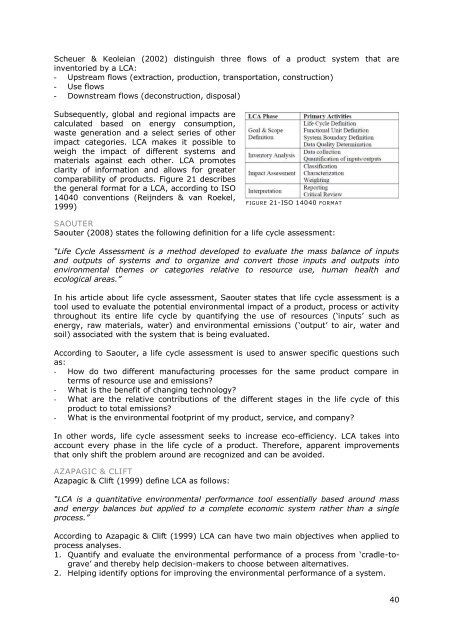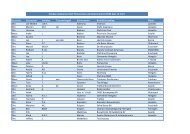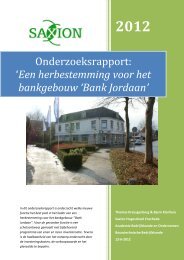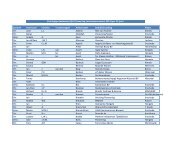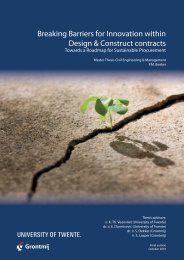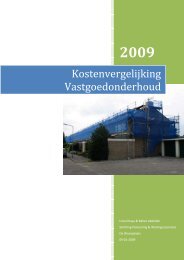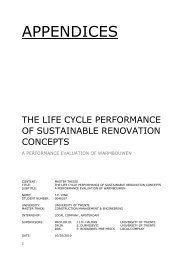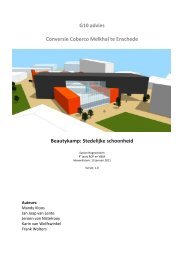the life cycle performance of sustainable renovation concepts
the life cycle performance of sustainable renovation concepts
the life cycle performance of sustainable renovation concepts
- No tags were found...
You also want an ePaper? Increase the reach of your titles
YUMPU automatically turns print PDFs into web optimized ePapers that Google loves.
Scheuer & Keoleian (2002) distinguish three flows <strong>of</strong> a product system that areinventoried by a LCA:- Upstream flows (extraction, production, transportation, construction)- Use flows- Downstream flows (deconstruction, disposal)Subsequently, global and regional impacts arecalculated based on energy consumption,waste generation and a select series <strong>of</strong> o<strong>the</strong>rimpact categories. LCA makes it possible toweigh <strong>the</strong> impact <strong>of</strong> different systems andmaterials against each o<strong>the</strong>r. LCA promotesclarity <strong>of</strong> information and allows for greatercomparability <strong>of</strong> products. Figure 21 describes<strong>the</strong> general format for a LCA, according to ISO14040 conventions (Reijnders & van Roekel,1999)FIGURE 21-ISO 14040 FORMATSAOUTERSaouter (2008) states <strong>the</strong> following definition for a <strong>life</strong> <strong>cycle</strong> assessment:“Life Cycle Assessment is a method developed to evaluate <strong>the</strong> mass balance <strong>of</strong> inputsand outputs <strong>of</strong> systems and to organize and convert those inputs and outputs intoenvironmental <strong>the</strong>mes or categories relative to resource use, human health andecological areas.”In his article about <strong>life</strong> <strong>cycle</strong> assessment, Saouter states that <strong>life</strong> <strong>cycle</strong> assessment is atool used to evaluate <strong>the</strong> potential environmental impact <strong>of</strong> a product, process or activitythroughout its entire <strong>life</strong> <strong>cycle</strong> by quantifying <strong>the</strong> use <strong>of</strong> resources („inputs‟ such asenergy, raw materials, water) and environmental emissions („output‟ to air, water andsoil) associated with <strong>the</strong> system that is being evaluated.According to Saouter, a <strong>life</strong> <strong>cycle</strong> assessment is used to answer specific questions suchas:- How do two different manufacturing processes for <strong>the</strong> same product compare interms <strong>of</strong> resource use and emissions?- What is <strong>the</strong> benefit <strong>of</strong> changing technology?- What are <strong>the</strong> relative contributions <strong>of</strong> <strong>the</strong> different stages in <strong>the</strong> <strong>life</strong> <strong>cycle</strong> <strong>of</strong> thisproduct to total emissions?- What is <strong>the</strong> environmental footprint <strong>of</strong> my product, service, and company?In o<strong>the</strong>r words, <strong>life</strong> <strong>cycle</strong> assessment seeks to increase eco-efficiency. LCA takes intoaccount every phase in <strong>the</strong> <strong>life</strong> <strong>cycle</strong> <strong>of</strong> a product. Therefore, apparent improvementsthat only shift <strong>the</strong> problem around are recognized and can be avoided.AZAPAGIC & CLIFTAzapagic & Clift (1999) define LCA as follows:“LCA is a quantitative environmental <strong>performance</strong> tool essentially based around massand energy balances but applied to a complete economic system ra<strong>the</strong>r than a singleprocess.”According to Azapagic & Clift (1999) LCA can have two main objectives when applied toprocess analyses.1. Quantify and evaluate <strong>the</strong> environmental <strong>performance</strong> <strong>of</strong> a process from „cradle-tograve‟and <strong>the</strong>reby help decision-makers to choose between alternatives.2. Helping identify options for improving <strong>the</strong> environmental <strong>performance</strong> <strong>of</strong> a system.40


